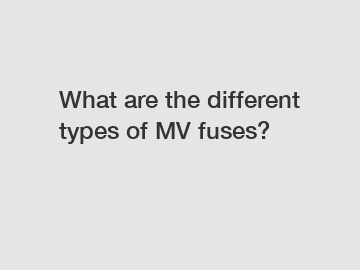What are the different types of MV fuses?
What are the different types of MV fuses?
MV fuses, also known as medium-voltage fuses, are essential electrical components used for protecting and isolating medium-voltage equipment from potential faults and damages. These fuses are designed to withstand the high levels of current typically found in medium-voltage applications. Let's take a closer look at the different types of MV fuses available in the market and their unique characteristics:
1. Expulsion Fuses:

Expulsion fuses are one of the most commonly used types of MV fuses. They consist of a fuse element housed in a cylindrical ceramic tube filled with high-purity, deionized gas. In normal operating conditions, the fuse element remains intact, allowing the current to flow uninterrupted. However, in the event of a fault, the fuse element melts and vaporizes due to the high current, creating an arc. The arc rapidly heats the gas, causing it to expand and expel the arc energy outside the tube. Expulsion fuses are characterized by their high breaking capacity and fast response time, making them suitable for various medium-voltage applications.
2. Current Limiting Fuses:
Current limiting fuses are specifically designed to limit the amount of current that flows through them during a fault. These fuses employ special materials or designs that create a rapid reduction in the current magnitude. As a result, their ability to limit the fault current provides increased protection to the electrical system, minimizing potential damage to connected devices. Current limiting fuses are valuable in applications where larger energy exposures need to be quickly curtailed, thus reducing the potential hazards associated with electrical faults.
3. High Rupturing Capacity (HRC) Fuses:
HRC fuses are designed to interrupt short circuits with high fault currents effectively. These fuses consist of a fuse element enclosed in a high-strength ceramic container filled with quartz sand. When a fault occurs, the fuse element melts due to the high current, creating an arc. The arc is quickly extinguished as the quartz sand absorbs the energy and suppresses the arc. HRC fuses are known for their robust construction and their excellent ability to interrupt fault currents while minimizing the damage to the equipment. They are widely used in industries that require highly reliable and resilient protection solutions.
4. Fuse Switch Disconnector:
Fuse switch disconnectors are a combination of a disconnector switch and a fuse. These devices provide a means to manually isolate and interrupt the circuit when necessary. Fuse switch disconnectors are typically used in medium-voltage distribution networks, allowing for easy maintenance and replacement of the fuse element without the need to shut down the entire system.
In conclusion, when it comes to medium-voltage applications, having the right type of MV fuse is crucial to ensure the safety and reliability of the electrical system. Expulsion fuses, current limiting fuses, high rupturing capacity fuses, and fuse switch disconnectors are just a few examples of the different types available. Each type offers unique characteristics and advantages, catering to specific requirements and applications. Therefore, it is essential to select the appropriate MV fuse based on the specific needs of the electrical system in question.
If you are looking for more details, kindly visit mining enterprises low-voltage power distribution cabinet, outdoor substation price, outdoor sf6 insulated rmu.


